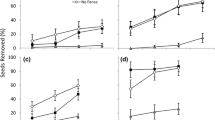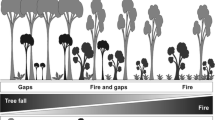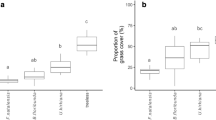Abstract
Seed predation and seedling mortality can act as strong demographic “bottlenecks” to sapling recruitment in African savanna woodlands. Fire also limits tree recruitment from saplings by suppressing their growth. I conducted field experiments with 13 woody plant species to assess the effects of seed burial on seedling emergence rates and effects of fire on seedling and sapling survival and growth rates over a period of 8 years at a savanna plot in central Zambia, southern Africa. Seed removal rates by small rodents varied among years and buried seeds had significantly higher emergence rates than seeds exposed to predators in most but not all the species. Annual burning reduced sapling growth in some species but in other species saplings experienced successive shoot die back even in the absence of fire. The findings show that for some woody species, seed predation is an important constraint to seedling recruitment but not for others and annual fires are important hindrances to demography and growth for some species but not others. Thus, demographic “bottlenecks” occur at different life history stages in different savanna woody species and these have the potential to alter woody tree competitive relationships and ultimately savanna structure.





Similar content being viewed by others
References
Analytical Software (1985–2008) Statistix 9: user’s manual. Tallahassee FL, USA
Ansell WFH (1978) The mammals of Zambia. The National Parks and Wildlife Service, Chilanga
Archibald S, Roy DP, van Wilgen BW, Scholes RJ (2009) What limits fire? An examination of drivers of burnt area in Southern Africa. Glob Change Biol 15:613–630
Boaler SB, Sciwale KC (1966) Ecology of a miombo site, Lupa North Forest Reserve, Tanzania. III. Effects on the vegetation of local cultivation practices. J Ecol 54:577–587
Bond WJ, Keeley JE (2005) Fire as a global ‘herbivore’: the ecology and evolution of flammable ecosystems. Trends Ecol Evol 20:387–394
Calvert GM (1986) Baikiaea regeneration and damaging agencies in Barotseland. In: Piearce GD (ed) The Zambezi teak forests. Zambia Forest Department, Ndola, pp 465–469
Chidumayo EN (1980) Population ecology of Tatera leucogaster (Rodentia) in southern Zambia. J Zool 190:325–335
Chidumayo EN (1997) Miombo ecology and management: an introduction. IT Publications, London
Chidumayo EN (2003) Effect of tillage, clipping and climate on grass phytomass in a Zambian savanna. J Trop Ecol 19:407–415
Delany MJ (1972) The ecology of small rodents in tropical Africa. Mamm Rev 1:1–42
Ferreira AV, Bruna EM, Vasconcelos HL (2011) Seed predators limit plant recruitment in Neotropical savannas. Oikos 120:1013–1022
Frost P (1996) The ecology of miombo woodlands. In: Campbell B (ed) The miombo in transition: woodlands and welfare in Africa. Center for International Forestry Research, Bagor, pp 11–57
Gambiza J, Bond W, Frost PGH, Higgins S (2000) A simulation model of miombo woodland dynamics under different management regimes. Ecol Econ 33:353–368
Gambiza J, Campbell BM, Moe SR, Frost PGH (2005) Fire behavior in a semi-arid Baikiaea plurijuga savanna woodland on Kalahari sands in western Zimbabwe. S Afr J Sci 101:239–244
Garcia-Orth X, Martinez-Ramos M (2008) Seed dynamics of early and late successional tree species in tropical abandoned pastures: seed burial as a way of evading predation. Restor Ecol 16(3):435–443
Grellier S, Barot S, Janeau J-L, Ward D (2012) Grass competition is more important than seed ingestion by livestock for Acacia recruitment in South Africa. Plant Ecol 213:899–908
Higgins SI, Bond WJ, Trollope WSW (2000) Fire, resprouting and variability: a recipe for grass-tree coexistence in savanna. J Ecol 88:213–229
Hoffmann WA (1999) Fire and population dynamics of woody plants in a Neotropical savanna: matrix model projections. Ecology 80:1354–1369
Keesing F (2000) Cryptic consumers and the ecology of an African savanna. Bioscience 50:205–215
Kunz BK, Linsenmair KE (2010) Fruit removal and seed predation in two African trees (Lannea acida and Lannea welwitschii, Anacardiaceae). West Afr J Appl Ecol 17:87–95
Lees HMN (1962) Working plan for the forests supplying the Copper belt, Western Province. Government Printer, Lusaka
Maclean JE, Goheen JR, Doak DF, Palmer TM, Young TP (2011) Cryptic herbivores mediate the strength and form of ungulate impacts on a long-lived savanna tree. Ecology 92:1626–1636
McConkey KM, Drakeb DR, Meehan HJ, Parsons N (2003) Husking stations provide evidence of seed predation by introduced rodents in Tongan rain forests. Biol Conserv 109:221–225
Miller MF (1994) Seed predation by nocturnal rodents in an African savanna ecosvstem. S Afr J Zool 29:262–266
Ostfeld RS, Manson RH, Canham CSD (1997) Effects of rodents on survival of tree seeds and seedlings invading old fields. Ecology 78(5):1531–1542
Saha S, Howe HF (2006) Stature of juvenile trees in response to anthropogenic fires in a tropical deciduous forest of Central India. Conserv Soc 4:619–627
Seymour C, Milton S (2003) A collation and overview of research information on Acacia erioloba (camelthorn) and identification of relevant research gaps to inform protection of the species. Department of Water Affairs and Forestry, Pretoria
Trollope WSW, Trollope LA (2002) Fire behavior a key factor in the fire ecology of African grasslands and savannas. In: Viegas DX (ed) Forest fire research & wildlands fire safety. Millpress, Rotterdam, pp 1–15
Vadigi S, Ward D (2012) Fire and nutrient gradient effects on the sapling ecology of four Acacia species in the presence of grass competition. Plant Ecol 213:1793–1802
Wakeling JL, Staver AC, Bond WJ (2011) Simply the best: the transition of savanna saplings to trees. Oikos. doi:10.1111/j.1600-0706.2011.19957.x
Wenny DG (2000) Seed dispersal, seed predation, and seedling recruitment of a Neotropical montane tree. Ecol Monogr 70:331–351
Werner PA (2012) Growth of juvenile and sapling trees differs with both fire season and understorey types: trade-offs and transitions out of the fire trap in an Australian savanna. Austral Ecol 37:644–657
White F (1962) The forest flora of Northern Rhodesia. Oxford University Press, Oxford
White F (1976) The underground forest of Africa: a preliminary review. Gard Bull 29:55–71
Author information
Authors and Affiliations
Corresponding author
Rights and permissions
About this article
Cite this article
Chidumayo, E.N. Effects of seed burial and fire on seedling and sapling recruitment, survival and growth of African savanna woody plant species. Plant Ecol 214, 103–114 (2013). https://doi.org/10.1007/s11258-012-0149-7
Received:
Accepted:
Published:
Issue Date:
DOI: https://doi.org/10.1007/s11258-012-0149-7




